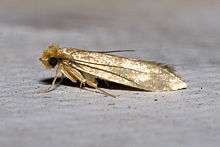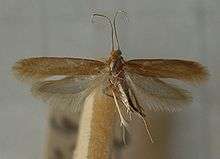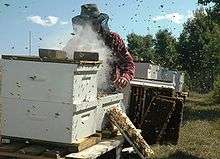Tineola bisselliella
- "Clothing moth" redirects here. This term may also refer to several other Tineidae.
| Tineola bisselliella | |
|---|---|
 | |
| Scientific classification | |
| Kingdom: | Animalia |
| Phylum: | Arthropoda |
| Class: | Insecta |
| Order: | Lepidoptera |
| Family: | Tineidae |
| Genus: | Tineola |
| Species: | T. bisselliella |
| Binomial name | |
| Tineola bisselliella (Hummel, 1823) | |
| Synonyms | |
|
Numerous, see text | |
Tineola bisselliella, known as the common clothes moth, webbing clothes moth, or simply clothing moth, is a species of fungus moth (family Tineidae, subfamily Tineinae). It is the type species of its genus Tineola. The specific name is commonly misspelled biselliella – for example by G. A. W. Herrich-Schäffer, when he established Tineola in 1853.[1]
The larvae (caterpillars) of this moth are considered a serious pest, as they can derive nourishment from clothing – in particular wool, but many other natural fibers – and also, like most related species, from stored foods, such as grains.
Life cycle
Females lay eggs in clusters of between 30 and 200 which adhere to surfaces with a gelatin-like glue. These hatch between four and ten days later into near-microscopic white caterpillars which immediately begin to feed. They will also spin mats under which to feed without being readily noticed and from which they will partially emerge at night or under dark conditions to acquire food. Development to the next stage takes place through between five and 45 instars typically over the course of between one month and two years until the pupal stage is reached. At this point, the caterpillars spin cocoons and spend another approximately 10–50 days developing into adults.[2]
After pupation is complete, the adult moths emerge and begin searching for mates. Females tend to move less than males, and both sexes prefer scuttling over surfaces to flying— some adults never fly at all. Adults can live for an additional 15–30 days, after which they die (otherwise death takes place shortly after mating for males and shortly after egg laying for females). Life cycle may be completed within one month under the most favorable conditions (75 °F (24 °C) and 70-75% relative humidity) but may take several years (lower temperatures and humidity will only slow development, larvae will still hatch and grow at temperatures as low as 10 °C (50 °F) and can survive up to 33 °C (91 °F)).[3][4]
Unlike the caterpillars, the adult moths do not feed: they acquire all of the nutrition and moisture they need while in the larval stage, and once they hatch from cocoons their only goal is to reproduce. They have only atrophied mouth parts and cannot feed on fabric or clothing. All feeding damage is done by the caterpillar (larval) form.[5] Heated buildings allow clothes moths to develop year-round. The overall life cycle from egg to egg typically takes 4–6 months, with two generations per year.[5]
Range and ecology



This moth's natural range is western Eurasia, but it has been transported by human travelers to other localities. For example, it is nowadays found in Australia. The species' presence has not been recorded in France, Greece, Slovenia and Switzerland, though this probably reflects the lack of occurrence data rather than absence.[6]
This species is notorious for feeding on clothing and natural fibers; they have the ability to digest keratin protein in wool and silk. The moths prefer dirty fabric for oviposition and are particularly attracted to carpeting and clothing that contains human sweat or other organic liquids which have been spilled onto them; traces of dirt may provide essential nutrients for larval development. Larvae are attracted to these areas not only for the food but for traces of moisture; they do not require liquid water.[2]
The range of recorded foodstuffs includes cotton, linen, silk and wool fabrics as well as furs. They will eat synthetic fibers if they are blended with wool.[5] Furthermore, they have been found on shed feathers and hair, bran, semolina and flour (possibly preferring wheat flour), biscuits, casein, and insect specimens in museums. In one case, living T. bisselliella caterpillars were found in salt. They had probably accidentally wandered there, as even to such a polyphagous species as this one pure sodium chloride has no nutritional value and is in fact a strong desiccant, but this still attests to their robustness.[7] Unfavorable temperature and humidity can slow development, but will not always stop it.
Both adults and larvae prefer low light conditions. Whereas many other Tineidae are drawn to light, common clothes moths seem to prefer dim or dark areas. If larvae find themselves in a well-lit room, they will try to relocate under furniture or carpet edges. Handmade rugs are a favorite, because it is easy for the larvae to crawl underneath and do their damage from below. They will also crawl under moldings at the edges of rooms in search of darkened areas where fibrous debris has gathered and which consequently hold good food.[5][2]
Pest control
Airtight containers should be used to prevent re-infestation once eggs, larvae, and moths are killed by any of these methods.[8] Control measures for T. bisselliella (and similar species) include the following:
- Anoxic measures work by displacing oxygen with an inert gas, asphyxiating the insects
- Carbon dioxide anoxia – Similar to cryofumigation, but using compressed dry carbon dioxide gas to exclude oxygen[9] Treatment for one week at 25 °C (77 °F) is recommended.[10]
- Nitrogen anoxia – Similar to cryofumigation, but using dry nitrogen gas to exclude oxygen[11] This process may cost more than carbon dioxide treatment.[12]
- Argon anoxia – Similar to cryofumigation, but using dry argon gas to exclude oxygen. This process may cost more than carbon dioxide treatment.[12]
- Physical measures
- Brushing vigorously in bright light can dislodge eggs and larvae, which may drop to the ground.[5]
- Clothing moth traps – Usually consisting of adhesive-lined cardboard enclosures baited with artificial pheromones, this measure can help monitor the current infestation and prevent males from mating with females.[5] Only males are drawn to the traps.
- Dry cleaning – This kills moths on existing clothing and helps remove moisture from clothes.[5]
- Freezing – Freezing the object for several days at temperatures below 18 °F (−8 °C) to kill larvae.[5][13] However, eggs survive freezing to -23°C.[14]
- Heat (120 °F or 49 °C for 30 minutes or more)[5] – these conditions may possibly be achieved by placing infested materials in an attic or sun-baked automobile in hot weather, or by washing clothes at or above this temperature. Specialist pest controllers can also provide various methods of heat treatment.
- Vacuuming – Since the moths like to hide in carpeting and baseboards (skirting), this is an important step towards full eradication. After thorough vacuuming, the bag should immediately be disposed of outside.[5]
- Mothproofing chemicals – Treatment of materials as a preventive measure before their use, as well as simply for storage, has a long history.[15] Arsenical compounds were effective in killing larvae but were considered too toxic for human contact even in the early twentieth century. Triphenyltin chloride was effective at 0.25%. After 1947, chlorinated hydrocarbon insecticides of many varieties were found to be effective at the low concentrations practical for preservative treatment.[15] Examples are chlordane at 2% per weight of wool, toxaphene at 0.8%, pentachlorophenol or BHC at 0.5%, DDT at 0.2%, chlordecone and mirex at 0.06%, and dieldrin at 0.05%. Imidazole (a non-chloronated aromatic heterocyclic) at 1% also gave satisfactory protection. Besides solvent-based applications, insecticidal dusts were commonly used to treat fabrics. In the 1950s EQ-53, a DDT emulsion, was recommended by the US Department of Agriculture to add to the final rinse of washable woolens, but even then cautions were given to the use of chlorinated hydrocarbons on items subject to commercial drycleaning. The 1985 United States EPA ban on most uses of Aldrin and Dieldrin exempted moth-proofing in a closed manufacturing process.[16] Triazole, thiazole, and imidazole derivatives have an anti-feeding effect on Tineola bisselliella larvae when wool is treated with these compounds. At 3% on mass of wool, both epoxiconazole and econazole nitrate protect wool fabric from Tineola bisselliella to the standard specified by Wools of New Zealand Test Method 25 (based on ISO 3998-1977(E).[17]
- Mothballs – Used primarily as a preservative but also will kill existing larvae if the concentration is high enough. There are two types of mothball: early twentieth century ones were often based on naphthalene, while mid twentieth century ones often used paradichlorobenzene. Both chemical crystals sublimate into a gas, which is heavier than air and needs to reach a high concentration around the protected material to be effective. Disadvantages: Vapors are toxic and carcinogenic; mothballs are poisonous and should not be put where they can be eaten by children or pets. Naphthalene mothballs are also highly flammable.
- Insecticides – Typically aerosol application works best if coverage is adequate. Treat once a month for the first three months and then once a quarter for the next year to ensure the infestation is under control.
- Permethrin – A particular synthetic pyrethroid available as aerosol spray. Disadvantages: very toxic to cats and fish. As Tineola bisselliella is the major worldwide pest for woollen products, permethrin-based agents have been commercialised for the protection of wool from this and other keratinophagous species.[18]
- Pyrethroids or pyrethrins (e.g. Cy-Kick, Deltamethrin, and d-Phenothrin which is used in 'Raid' fly spray[19] ) – Synthetic or natural pyrethrins available as aerosol spray or as dusts. Disadvantages: some are persistent in the ecosystem and toxic to fish, possibly resistance.
- Pyriproxyfen (or other juvenile hormone analogs) – Stops the life cycle by preventing the caterpillars from pupating.
- Bifenthrin - A synthetic pyrethroid commercialised as an alternative to permethrin, for the protection of woollen products from Tineola bisselliella and other species.[18]
- Chlorfenapyr - A halogenated pyrrole insecticide commercialised as an alternative to synthetic pyrethroid insecticides in the protection of woollen products from Tineola bisselliella and other species.[18]
- Biological measures
- Camphor – Possibly safer and more "natural" alternative to mothballs, but may require high vapor concentrations
- Eastern red cedar – Questionable value as long-term deterrent. While the volatile oil is able to kill small larvae, it is difficult to maintain sufficient concentrations of it around stored articles to be effective; cedar wood loses all moth-suppressant capabilities after a few years.[5] Distilled red cedar oil is commercially available to renew dried-out cedar wood. Airtight construction is more important than the type of wood used to make a container.[5]
- Lavender – Either bags with dried lavender flowers are put into the wardrobe (they can be refreshed by putting a few drops of lavender oil on them), or a few drops of lavender oil are put on a piece of fabric which is then deposited in the wardrobe and periodically refreshed. Disadvantage: strong "perfumed" smell.
- Trichogrammatid wasps (e.g. Trichogramma evanescens) – Tiny parasitoid wasps which place their own eggs inside those of the moths; their larvae eat the moth eggs. Trichogrammatid wasps are harmless to humans, measuring only about 2 millimetres (0.079 in). Once moth eggs are eaten, the wasps vanish within 2–4 weeks.
Synonyms
The common clothes moth is such a widespread and frequently seen species that it has been described time and again under a variety of junior synonyms and other now-invalid scientific names:[20]
- Paracharactis vestianella (sensu auct., non Linnaeus, 1758: preoccupied)
- Tinea biselliella (lapsus)
- Tinea bisselliella Hummel, 1823
- Tinea crinella Sodoffsky, 1830[21]
- Tinea destructor Stephens, 1834
- Tinea flavifrontella Thunberg, 1794 (non Denis & Schiffermüller, 1775: preoccupied)
- Tinea lanariella Clemens, 1859
- Tinea vestianella (sensu auct., non Linnaeus, 1758: preoccupied)
- Tineoila biselliella (lapsus)
- Tineoila crinella (Sodoffsky, 1830)[21]
- Tineoila destructor (Stephens, 1834)
- Tineoila lanariella (Clemens, 1859)
- Tineoila furciferella Zaguljaev, 1954
Footnotes
- ↑ Pitkin & Jenkins (2004), FE (2009), and see references in Savela (2003)
- 1 2 3 "Webbing Clothes Moth" (PDF). MuseumPests.net. Integrated Pest Management Working Group. Retrieved 2015-05-20.
- ↑ John A. Jackman; Bastiaan M. Drees (1 March 1998). A Field Guide to Common Texas Insects. Taylor Trade. p. 227. ISBN 978-1-4616-2291-8.
- ↑ Jane Merritt; Julie A. Reilly (16 January 2010). Preventive Conservation for Historic House Museums. Rowman Altamira. p. 112. ISBN 978-0-7591-1941-3.
- 1 2 3 4 5 6 7 8 9 10 11 12 Choe, D.-H. "Clothes moths". UC IPM Online. Agriculture and Natural Resources, University of California. Retrieved 2014-09-15.
- ↑ ABRS (2008), FE (2009)
- ↑ Grabe (1942)
- ↑ "Solutions: Isolation/Bagging". MuseumPests.net. Integrated Pest Management Working Group. Retrieved 2015-05-20.
- ↑ "Solutions: Carbon Dioxide Treatment". MuseumPests.net. Integrated Pest Management Working Group. Retrieved 2015-05-20.
- ↑ "Insect Mortality under Anoxia". Keepsafe. Keepsafe Microclimate Systems. Retrieved 2015-05-20.
- ↑ Daniel, Vinod; et al. (25 October 1993). "Nitrogen Anoxia of The Back Seat Dodge 38: A Pest Eradication Case Study". WAAC Newsletter. Retrieved 2011-07-29.
- 1 2 "Solutions: Nitrogen/Argon Gas Treatment". MuseumPests.net. Integrated Pest Management Working Group. Retrieved 2015-05-20.
- ↑ "Solutions: Low Temperature Treatment". MuseumPests.net. Integrated Pest Management Working Group. Retrieved 2015-05-20.
- ↑ "Comparison in vitro and in vivo efficiencies of three attractant products against webbing clothes moth Tineola bisselliella (Hummel) (Lepidoptera: Tineidae)". Journal of Stored Products Research. 50: 15–20. 2012-07-01. doi:10.1016/j.jspr.2012.03.004. ISSN 0022-474X.
- 1 2 Prakash, Om; Banerjee, J.; Parthasarathy, L. (July 1979), "Preservation of Woollens Against Clothes Moths and Carpet Beetles" (PDF), Defense Science Journal, 29: 147–150
- ↑ "Aldrin/Dieldrin". US Environmental Protection Agency.
- ↑ Sunderland, M. R.; Cruickshank, R. H.; Leighs, S. J. (2014). “The efficacy of antifungal azole and antiprotozoal compounds in protection of wool from keratin-digesting insect larvae”. Textile Research Journal 84 (9): 924–931. http://trj.sagepub.com/content/84/9/924
- 1 2 3 Ingham, P. E.; McNeil, S. J.; Sunderland, M. R. (2012). "Functional finishes for wool – Eco considerations". Advanced Materials Research, 441: 33–43. http://www.scientific.net/AMR.441.33
- ↑ "Raid Ingredients".
- ↑ ABRS (2008), Robinson [2010]
- 1 2 Sometimes attributed to Treitschke (1832) in error: see e.g. references in Savela (2003)
References
- Australian Biological Resources Study (ABRS) (2008): Australian Faunal Directory – Tineola bisselliella. Version of October 9, 2008. Retrieved May 6, 2010.
- Grabe, Albert (1942): Eigenartige Geschmacksrichtungen bei Kleinschmetterlingsraupen ["Strange tastes among micromoth caterpillars"]. Zeitschrift des Wiener Entomologen-Vereins 27: 105-109 [in German]. PDF fulltext
- Pitkin, Brian & Jenkins, Paul (2004): Butterflies and Moths of the World, Generic Names and their Type-species – Tineola. Version of November 5, 2004. Retrieved May 6, 2010.
- Robinson, Gaden S. [2010]: Global Taxonomic Database of Tineidae (Lepidoptera) – Tineola bisselliella. Retrieved May 6, 2010.
- Savela, Markku (2003): Markku Savela's Lepidoptera and some other life forms – Tineola. Version of December 28, 2003. Retrieved 2010-MAY-06.
External links
| Wikimedia Commons has media related to Tineola bisselliella. |
- Clothes Moths Management Guidelines
- Ohio State University Extension Fact Sheet at the Wayback Machine (archived June 17, 2008)
- Clothes Moths, Kansas State University
- Lepiforum.de
